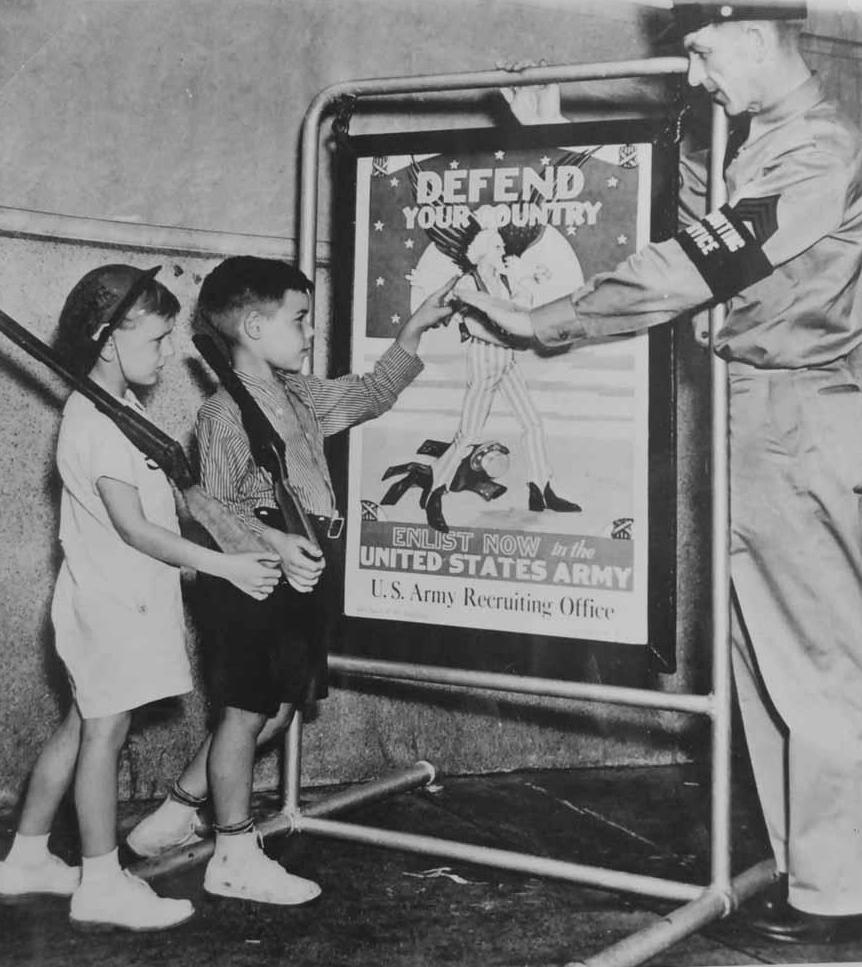
World War II: The American Draft--Significance

Figure 1.--This image from Camden, New Jersey appeared in American newspapers at the time President Roosevelt had asked Congress to authorize the country's first peace time draft. The caption read, "Little patriots: Armed with their toy double-barreled shotguns, two six-year-old yourhs, Richard Cramer (left) and James Nardelli, tell the recruiting sergeant they want to join the Army. But the sergeant said 'No'. It seems the boys were a little too small. The photograph was dated August 16, 1940. This light-hearted image actually dealt with a deadly serious issue. America was powerless to defend itself against the massive conscipt armies of the Axis. Advocating a peace time draft during the President's contenious 1940 reelection campaign was an action of immense political courage. It also marked the central turning point in America's steps to confront Axis aggression.
|
|
President Roosevelt with Germany's and Japan's aggresive moves had moved forward to expand the Navy and begin building a large air force. There was opposition from some isolationists, including Congressional Reopublicans. Appropriations for national defense, however, did not ignite unsurmountable public opposition. A peacetime draft was potentially a much more volitile effort. It was not just about appropriations. It was about conscripting young men--husbands and sons. This was an issue that the isolationists could use that would resonate with many Americans. But America without a massive army was no deterent to the Germans and Japanese with huge conscript armies. Just as Hitler's resumption of conscription was the turning point in German rearmament. American adoption of a peace-time draft would be the turning point in Americam military preparadness. There were sufficent volunteers out of patriotism or other reasons for a small peace-time army, especialy during the Depression. Building an army on a World War II scale capable of taking on the massive conscript armies of Germany and Japan was a very different matter. A disarmed and feeble United States was central to Hitler's strategic thinking. Only conscription would bring in the number of men needed. And this was espcially the case before the United States was actually in the War. Not having a large consript army not only put the United States in danger, but mean that it would be more than a year before the United States could conduct meaningful military operations when the United States actually got involved. This was precisely what hapened in World War I. The United States declared war (April 1917), but it was a year before American ground forces made any real contrbution to the Allied effort. The American infantry was not fully in place when the Germans launched their massive Spring offensive. The Allies, as a result, came very clos to loing the War. If America was going to defend itself in World War II, let alone deter Axis aggresion, a massive army would be needed. President Rooevelt and General Marshall knew this. It was less clear to the American people who still still resistied the idea of participating in another European war. And the only way to obtain the the number of men needed was military conscription--the draft. This was President Roosevelt's greatest challenge, to convince Americans that a peace time draft was needed. This was a tough sell and he had to do it in of all times in the middle of the seriously contested 1940 presidential election campaign in which he was challeging the long-established two-term limit. This was one of the most courageous decisions in American political history. It should be noted that it was the men drafted in 1940 that comprised most of the trained forces America had in place when the Japanese struck at Pearl Harbor December 1940). They were the men that were rushed to Australia tp prevent a Japanese nvasion and enabled the United States to begin its offensive actions, first at Guadalcanal (August 1942) and North Africa (November 1942).
CIH -- WW II

Navigate the HBC World War II Section:
[Return to Main American conscription page]
[Return to Main Arsenal of Democracy--inter-war page]
[Return to Main age and conscription page]
[Return to Main World War II American isolation page]
[Biographies]
[Campaigns]
[Children]
[Countries]
[Deciding factors]
[Diplomacy]
[Geo-political crisis]
[Economics]
[Home front]
[Intelligence]
[POWs]
[Resistance]
[Race]
[Refugees]
[Technology]
[Bibliographies]
[Contributions]
[FAQs]
[Images]
[Links]
[Registration]
[Tools]
[Return to Main World War II page]
[Return to Main war essay page]
Created: 1:20 PM 4/29/2015
Last updated: 1:20 PM 4/29/2015



